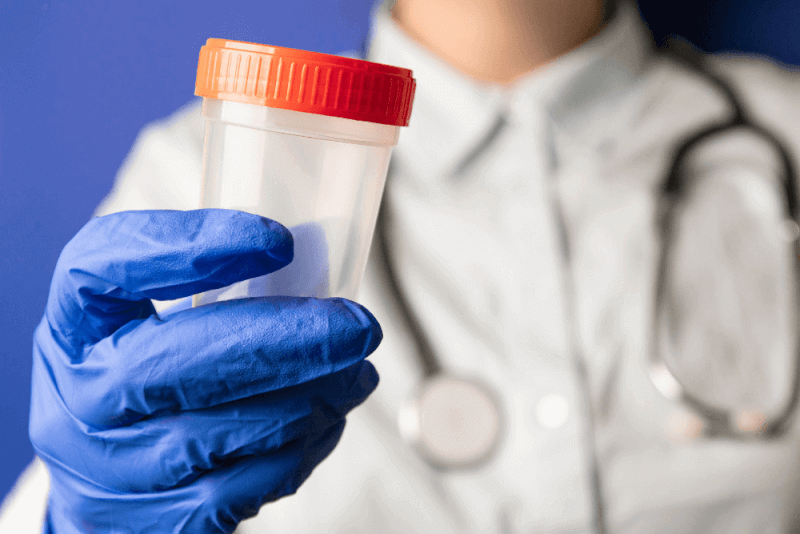30-Second Summary
- Genital warts, also known as condylomas, are among the most common sexually transmitted diseases.
- As with almost all types of warts, condylomas are caused by human papillomaviruses, or HPV. They primarily enter the body through unprotected sexual contact.
- There are numerous types of HPV. Types 6 and 11 typically lead to genital warts. Types 16 or 18 are also rarely found in skin growths. These two HPV types are considered primary risk factors for cervical cancer.
- Eczema on the skin or mucous membranes caused by a fungal infection in the genital area, discharge, and fine tears can facilitate virus transmission. Genital warts are more likely to develop when the immune system is weakened.
What is a Genital Wart (Condyloma)?
|
Genital warts, also known as condylomas, are among the most common sexually transmitted diseases and are caused by an infection with human papillomavirus (HPV). |
Genital warts are benign skin growths, often resembling a pinhead-sized lump, and appear reddish, brownish, or grayish-white in color. Condylomas colonize the genital or anal area and are among the most common sexually transmitted diseases. They usually appear in large numbers and are close to each other, in which case doctors refer to wart beds. These formations typically do not cause discomfort but may cause itching in sensitive skin areas.
As with almost all types of warts, condylomas are caused by human papillomaviruses, or HPV. They primarily enter the body through unprotected sexual contact. HPV types 6 and 11 are most commonly found in genital warts. Unlike types 16 and 18, experts estimate the cancer risk from these papillomaviruses for cervical cancer to be very low. The viruses nest in the upper layers of the skin but do not necessarily cause a wart. However, if favorable factors such as a weakened immune system are present, it may lead to skin proliferation and wart formation.
Doctors usually recognize genital warts by their characteristic appearance. They examine not only the affected part of the body but also the anus, rectum, vagina, and cervix, as the growths can spread unnoticed to these areas.
Depending on the location and extent of the condylomas, different treatment strategies exist. Patients often need to apply special solutions or creams for several weeks. Particularly stubborn warts may also be surgically removed.
Types of Genital Warts (Condylomas)
Different types of HPV cause various genital warts, which can be further classified into subtypes. The main types of genital warts include the following:
Condyloma Acuminata
Commonly seen condyloma acuminata typically appears on the external genital organs, perianal skin, perineum, or groin. They are usually seen as soft papules or plaques. The HPV types that cause this type are 6 and 11.
Papular Warts
Papular warts, which appear in groups, can be skin-colored or white. These flat warts are frequently found around the anus, at the vaginal entrance, and on the penis.
Flat Warts
Also known as flat warts, this type consists of small, smooth, non-cancerous growths on the skin. They have a flatter structure compared to other warts and are usually as small as a pinhead. These warts, which can be pink or skin-colored, often appear in groups. As a result, their numbers can range from a dozen to a hundred in a specific area.
Keratotic Warts
These warts, commonly seen around the anus or on the penis, have a harder structure compared to other types. Due to their bumpy surface, they have a cauliflower-like appearance.
Internal Warts
Warts located within the inner parts of the genital areas are called internal warts. They are generally found in the anal canal, cervix, and inner parts of the vagina. These warts typically do not cause any pain and are usually detected during routine examinations.
Causes of Genital Warts (Condylomas)
Genital warts are caused by the human papillomavirus, or HPV. The viruses primarily spread to the skin through unprotected sexual intercourse. They can penetrate the upper layer of the skin or mucous membrane and nest in small injuries on the penis, vagina, anus, or rectum.
Rarely, HPV can also spread through sharing towels or bathing with an infected person. If a mother has contracted the pathogens, she may transmit the viruses to the newborn during birth.
There are numerous types of HPV. Types 6 and 11 typically lead to genital warts. Types 16 or 18 are rarely found in skin growths but are considered primary risk factors for cervical cancer. However, experts believe the likelihood of a genital wart turning into a malignant tumor is very low.
For instance, eczema on the skin or mucous membranes caused by a fungal infection in the genital area, discharge, and fine tears can facilitate virus transmission. Genital warts are more likely to develop when the immune system is weakened, as the viruses can replicate particularly quickly in this case. People with HIV/AIDS or those taking immunosuppressive medications may experience condylomas more frequently.
Symptoms of Genital Warts (Condylomas)
The specific appearances of genital warts are as follows:
- Rough surface
- Skin-colored or whitish-gray
- May appear cauliflower-like or flat
- Some warts may be very small but still visible to the eye
- In some cases, warts can cluster and grow significantly larger
- Some clusters may have stalk formations
The complaints that genital warts may cause include the following:
- While warts are generally painless, some may cause pain
- Mild bleeding
- Burning sensation
- Discomfort
- Itching in the genital area
- Irritation in the genital area
- Increased discharge
How Are Genital Warts (Condylomas) Diagnosed?
If genital warts are suspected, the doctor examines the anus and genital area. If characteristic skin regions are found, they are closely inspected. If necessary, the doctor may take a small tissue sample (biopsy) under local anesthesia and have it examined under a microscope. If genital warts are located on the mucous membrane of the intimate area, diagnosis can be more difficult.
For this reason, internal condylomas often go unnoticed for a long time. If genital warts have formed in the rectum, a colonoscopy may be performed. If they affect the urethra, urethral endoscopy may be considered. Since human papillomavirus is sexually transmitted, the infected person's sexual partner should also be tested.
PAP Test
It is extremely important for women to have regular PAP Smear tests. This test can detect changes in the vagina and cervix caused by genital warts and can also identify early signs of cervical cancer. The samples taken are examined under a microscope to check for any irregularities in the cells.
HPV Test
Although there are many different types of HPV, only a few are associated with cervical cancer. For this reason, HPV tests are conducted to determine if an individual has HPV types that could lead to cervical cancer.
This test is generally administered to women over the age of 30, as it is not beneficial for younger women. In this age group, HPV often clears up on its own without treatment.
How Are Genital Warts (Condylomas) Treated?
External genital warts can often be treated by the affected individual. For this purpose, a doctor may prescribe a solution or cream containing the active ingredient podophyllotoxin or a cream with ingredients such as epigallocatechin gallate and imiquimod.Podophyllotoxin inhibits cell division and causes infected cells in genital warts to die. Epigallocatechin gallate is a green tea derivative.
It also helps condylomas regress through various mechanisms but is used only in very high concentrations. Imiquimod activates the skin's defense system, causing the body's own immune cells to attack the wart pathogens more aggressively.
Patients must use these medications regularly for several weeks. If skin irritation occurs, the doctor may, depending on the severity, halt treatment for a few days until the skin calms down.For some patients, such as those with internal genital warts, self-treatment is not an option. Depending on their location and extent, the doctor may remove condylomas using various methods.
For example, if small genital warts are found on the vaginal mucous membrane, urethral opening, or anal canal, the doctor may use trichloroacetic acid. This acid kills genital warts. To do this, the doctor applies the substance to the skin growths with a cotton swab and repeats the treatment at weekly intervals.
Alternatively, genital warts can be frozen by applying liquid nitrogen to the affected areas with a cotton swab. Since both procedures can cause pain, the doctor may use local anesthesia beforehand, depending on the location, number, and size of the skin growths.
Laser Treatment for Genital Warts
Laser treatment is also an option among the treatment choices for genital warts. Laser treatment, a surgical procedure, can be performed in the doctor's clinic. Local anesthesia is typically used during the procedure, but general anesthesia is also an option. The type of anesthesia used depends on the number of warts and the size of the area to be treated.
The recovery period after laser treatment for genital warts is proportional to the number of warts removed. Healing generally occurs within 2 to 4 weeks.
It is recommended to avoid sexual intercourse until the treated area has healed and pain has subsided, typically within 1 to 3 weeks.
Reasons for preferring laser surgery include the following:
- Ineffectiveness of medications in treating the warts
- Extensive spread of warts
- Requirement to treat warts during pregnancy
Risks of Laser Treatment for Genital Warts
Risks associated with the laser treatment of genital warts include the following:
- Pain
- Swelling
- Itching
- Wounds in the treated area
- Adhesions of tissue
- Scarring
Surgical Method for Genital Warts
The surgical method is preferred for genital warts when medications are ineffective, the warts cover a large area, or in cases of pregnancy. The surgical methods used to treat genital warts include the following:
Electrocauterization
This procedure uses electric current to burn the warts. Afterward, some pain and swelling may be experienced.
Surgical Excision
Surgical excision is the process of cutting the warts with surgery. Anesthesia is administered to prevent the patient from feeling pain during this procedure, but patients may feel pain once the anesthesia wears off.
Cryotherapy Treatment for Genital Warts
This method, commonly used for freezing lesions, is also preferred for removing genital warts. Liquid nitrogen is used for freezing. Some experts recommend cryotherapy as a primary approach for treating genital warts. Although the HPV virus on the skin surface may be eliminated with this method, the warts may recur due to viruses remaining under the skin. However, regular application can help reduce the virus population in the area.
Cryotherapy is applied in sessions. The area to be treated may vary based on the patient’s pain tolerance. Healing is expected between sessions, typically taking 7 to 10 days. It is recommended to adopt an aggressive approach to prevent warts from regrowing due to long intervals between sessions.
Risk Factors for Genital Warts (Condylomas)
HPV types cause genital warts. More than forty types of human papillomavirus can lead to genital warts. The virus spreads through skin contact during sexual intercourse. Warts on other parts of the body are caused by a different type of HPV, so warts on hands or feet do not cause genital warts. The transmission routes of genital warts include the following:
- Sexual intercourse, including anal, vaginal-penile, or vaginal-vaginal contact
- Skin contact without ejaculation
- Having sexual intercourse with someone who has HPV or genital warts
- Oral sex with someone carrying HPV or having genital warts in their mouth, lips, or tongue
A significant portion of sexually active individuals are infected with HPV. Factors that may increase the risk of infection include the following:
- Not receiving the HPV vaccine
- Having sexual intercourse without a condom or with multiple partners
- Having a history of another sexually transmitted infection
- Engaging in sexual activity at a young age
- Having a weakened immune system due to conditions such as HIV or medications following organ transplants
Why Do Genital Warts Frequently Recur?
Genital warts may recur (relapse) even after treatment. This is possible with all the mentioned therapy methods, regardless of whether the individual treats the condylomas themselves or the doctor removes the warts. The reason is that viruses cannot always be completely eliminated through treatment.
Additionally, cells near the condylomas may already be infected with the virus, even though the skin in these areas may not appear visibly affected. Therefore, in certain cases, it may be advisable to treat the surrounding skin with ointment in addition to visible genital warts, or to conduct comprehensive follow-up treatment after surgically removing skin formations.
Ways to Prevent Genital Warts (Condylomas)
To prevent genital warts, the HPV vaccine should be prioritized. Key points to consider include:
- Limiting the number of sexual partners is recommended for those with an active sexual life.
- Having sexual intercourse with a single partner is safer.
- Condoms should be used during sexual intercourse. HPV primarily spreads through unprotected sexual contact, direct skin-to-skin contact, or smear infections. Condoms can reduce the risk of genital warts if they are on the vagina or penis. However, if there is a wart elsewhere in the genital area, condoms do not provide protection.
- If one partner is infected, the other should avoid direct skin contact. Separate bath and hand towels are recommended.
The HPV vaccine provides protection against various types of HPV. Its primary purpose is to prevent cervical cancer.
What to Consider Regarding Genital Warts (Condylomas) During Pregnancy
Important points to consider regarding genital warts and HPV during pregnancy are as follows:
- Medications containing podophyllotoxin should not be used: This active ingredient is not suitable for pregnant women as it inhibits cell division.
- Doctor supervision is essential if genital warts are present: If the expectant mother has genital warts, treatment by a doctor is necessary.
- Treatment choice should be made by the doctor: Safe treatment methods such as surgical intervention or cryotherapy are preferred for wart treatment during pregnancy.
- Immune system weakening should be monitored: Since the immune system may weaken during pregnancy, the risk of warts growing or spreading may increase. Therefore, regular medical check-ups are important.
- A healthy lifestyle should be adopted: Factors that weaken the immune system, such as stress, poor nutrition, and smoking, should be avoided.
- There is a risk of HPV transmission to the baby during childbirth: Although this risk is generally low, the delivery method (normal delivery or cesarean) should be determined under a doctor's guidance.
- Cesarean delivery may be preferred for large warts: In some cases, cesarean delivery may be recommended depending on the size of the genital warts.







